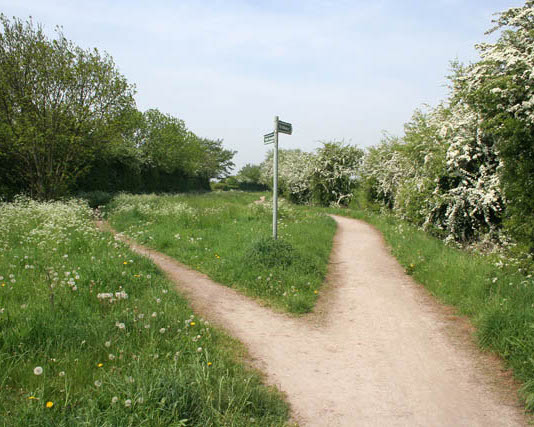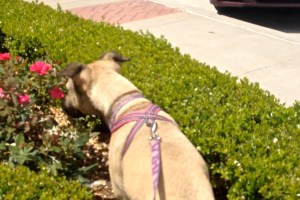Barks Blog
Not All “Choices” Are Equal
Shout-outs to Companion Animal Psychology for the post, The Right to Walk Away” which covers the effects of offering that particular choice in animal experiments, and encourages us to apply the concept to our animals’ lives. Also to Yvette Van Veen for her piece, “A” Sucks “B” Stinks What Kind of Choice is That? , which definitely has some “rant” commonalities with this post of mine.
We positive reinforcement-based trainers often point out that our dogs have the choice not to participate in a training session. I think giving the animal “the right to walk away” is a good and humane practice. I also believe it’s only the first step of consideration of our animals’ self-determination.
Trainers who exclusively use aversives to train employ the language of choice as well. Shock trainers will say that the dog “is in control of the shock” and that the dog has a choice. In that case the choice is to comply–or not. Neither of the choices yields positive reinforcement. But these trainers too can honestly claim their dogs have choices.
Most of us would say that theirs is a pretty strained use of the term, “choice.” It’s a very stacked deck, and even the best option–successful avoidance–is not a fun one for the dog. But using the definitions of learning theory, neither of those situations–the positive reinforcement-based trainer giving the dog the right to leave, nor the shock-only trainer–would qualify as giving the animal a “free choice.”
I’m going to argue here that limiting choices is intrinsic to the process of training an animal, whatever method we use. It’s the nature of the process. And it’s actually not “choices” or “no choices” that define a method’s humaneness. It’s what kinds of choices are available within the structure we set up that determines how humane it is.
We all stack the deck.
When anyone talks about giving their animal choices, I believe we need to ask questions.
- What can the animal choose between?
- What processes of learning are involved?
- Is an aversive stimulus a focal point of the choice making?
- What choices are ruled out?
- Will the choices broaden later in training?
Not all choice situations are equal, and I think we need to knock off the instant happy dances anytime a person mentions “choice” in reference to training. Instead, I think we should ask, “What are the choices?”
How Much Choice Are We Giving?
How many times have you read one of the following instructions in a positive reinforcement group or forum? They are often addressed to new trainers, or trainers with puppies.
- Be sure and begin your training in an area of low distraction.
- Control other possible reinforcers.
- If you can’t get the dog’s attention, start in the bathroom with the door closed and wait him out.
- Don’t let the dog practice undesirable behaviors.
- Watch out for bootleg reinforcers!
All of those are about limiting choices by removing the availability of reinforcers. We need to acknowledge the ways in which we do that. But there is no contradiction here. As trainers using primarily positive reinforcement, we are in the best position to look at the ways that this kind of choice management affects our dogs’ lives, and examine the ways we can move forward to a more choice-rich environment for them.
The Desirability of Choice
Many experiments have shown that animals and humans prefer having multiple paths to a reinforcer, and of course options for different reinforcers as well.
This is from a webpage that describes one of the important experiments with animals regarding choice. The experiment introduced some interesting nomenclature.
The classic experiment on preference for free choice was done by A. Charles Catania and Terje Sagvolden and published in 1980 in the Journal of the Experimental Analysis of Behavior, “Preference for Free Choice Over Forced Choice in Pigeons.”
The design was simple. In the first stage of each trial, pigeons could peck one of two keys. One key produced a “free choice” situation in which the pigeon saw a row of four keys: three green and one red. Pecks on the other key produced a “forced-choice” situation in which the pigeon saw one green key and three red keys. In either situation, pecking a green key produced food. Pecking a red key produced nothing. The arrangement of the colors varied from trial to trial.
Even though all the pigeons reliably pecked a green key in either situation, always earning food, they selected the free-choice situation about 70% of time. This shows that just having a choice is reinforcing, even if the rate of the reinforcement in both situations is exactly the same. Behavior Analysis and Behaviorism Q & A
Another good article about the Catania experiments and other work on choice is, “On Choice, Preference, and Preference for Choice” by Toby Martin et al.
(In no way can this short post cover all the nuanced research about choice. For instance, abundance of choice has a downside , especially for humans. I am sticking to the issues of choice that are most applicable to the situations our companion animals find themselves in.)
“Forced Choice”
Note the definition of “forced choice” in the description of the experiments above. Nothing happened when the pigeon pecked the red key. The bird was not shocked or otherwise hurt. Forced choice was defined as a situation where only one behavior led to positive reinforcement (more correctly, a appetitive stimulus), and another behavior or behaviors led nowhere.
Having more than one behavioral path (in this case, multiple green keys to press) to get to the goodie was defined as “free choice.”
Now, think back to what we do in the early stages of training. Review my list above of the ways we remove “distractions,” i.e., other reinforcers. That type of training situation more closely resembles forced choice than free choice. The freedom to leave–especially in an environment that lacks other interesting stimuli–is not enough to designate a process as being free choice, at least in the nomenclature of this experiment and subsequent definitions in learning theory. But it’s a good first step.
Types of Choice
Here are the types of “choice” setups I see most commonly in dog training.
- Choice between different behaviors that lead to positive reinforcement. See examples below.
- Choice between handler-mediated positively reinforced behaviors and nothing in particular. This is the typical “they can walk away” type of positive reinforcement training session.
- Choice between different positively reinforced behaviors with an aversive present. This can happen in exposure protocols if the trigger is close enough that it is at an aversive level. The proximity limits the value of positive reinforcement, and, if the aversive gets too close, eliminates it, because of the sympathetic “fight or flight” response.
- Choice between enduring an aversive stimulus and performing a behavior that allows escaping it. Most shock collar training exemplifies this, as do operant exposure protocols that put contingencies on escaping the trigger.
- Choice between behaviors that are positively reinforced and behaviors that are positively punished. A training situation such as “walk in heel position, get a cookie; surge forward, get a collar pop.”
- Choice between behaviors that are positively punished and behaviors that get nothing in particular. This would be across-the-board suppression of behavior.
In all that I listed, even #6, the dog can be said to have a choice. But none of them, with the exception of #1, would likely be called “free choice” in learning theory nomenclature.
Now, about #1. The things I would tentatively put in the “free choice” bucket are:
- Desensitization/counterconditioning with the trigger at a non-aversive level. The leash or other barrier prevents or controls the choice of movement towards the trigger, but there are no contingencies on behavior within the area and multiple reinforcers may be available.
- Shaping, which can offer multiple choices of behavior along the path to a goal behavior.
- Reinforcing offered behaviors in day-to-day life with an animal. (I’ll write about this in my follow-up post.)
- Training techniques that allow the dog to leave in pursuit of another interest. However, these as well do tend to have a final goal of another behavior.
Note that we are not talking about using a variety of reinforcers. That’s easy to do in training. We are talking about different behaviors leading to reinforcement. When you are focused on a training goal, that one is a lot harder to include!
A Word About Preference
Preference is not the same as choice, though they are related.
From a review article about choice:
Preference is the relative strength of discriminated operants Researchers often measure preference as a pattern of choosing. –Martin, Toby L., et al. “On choice, preference, and preference for choice.” The behavior analyst today 7.2 (2006): 234.
Pattern is a key word. I may not like my green tee-shirt very much, but I will choose it if my red ones are in the wash. It is only by observing my tee-shirt choice over time, noting circumstances and performing a bit of statistical analysis, that my choices will indicate my preference (red tee-shirts).
Observing our pets’ preferences, and giving them their preferred items, is a good and thoughtful thing, but doing so does not necessarily involve their making a choice.
In addition, determining an animal’s preferences in a formal way can be more difficult than it sounds. But scientists are developing ways to determine choice in animals. The following article covers some of these: Using Preference, Motivation, and Aversion Tests to Ask Scientific Questions about Animals’ Feelings.
Acknowledging Limitations on Choice
I think that when we talk about giving dogs choices, or describe protocols that supposedly do this, we should consider two things. First what are the choices? Are there multiple possibilities for positive reinforcement, or are there choices between positive reinforcement and nothing, or only crummy choices?
Second, we should consider how we are limiting choices. Are the limitations temporary or permanent? Are there ways we can give our dogs ways to express their preferences and make choices in their lives with us? Even in training?
There is no barb intended for positive reinforcement-based trainers in this post. Giving the animal the right to walk away is revolutionary in the recent training climate. We are the ones taking that step. Sometimes it’s the most control we can give them. But I believe we can do more.
Part 2 of this post will include my attempts–successful or not so–in giving my dogs choices in different situations.
How about you out there? In what ways do you give your animals choices–in day-to-day life or in training?
Articles Mentioned
- The Right to Walk Away
- “A” Sucks “B” Stinks What Kind of Choice is That?
- On Choice, Preference, and Preference for Choice
- Behavior Analysis and Behaviorism Q & A
- Using Preference, Motivation, and Aversion Tests to Ask Scientific Questions about Animals’ Feelings
- Making Choices Impairs Subsequent Self-Control: A Limited-Resource Account of Decision Making, Self-Regulation, and Active Initiative
To learn more about force-free training for all pets, join fellow pet professionals and owners at the pet Professional Guild’s inaugural Force-Free Summit in Tampa, FL on November 11-13, 2015.



